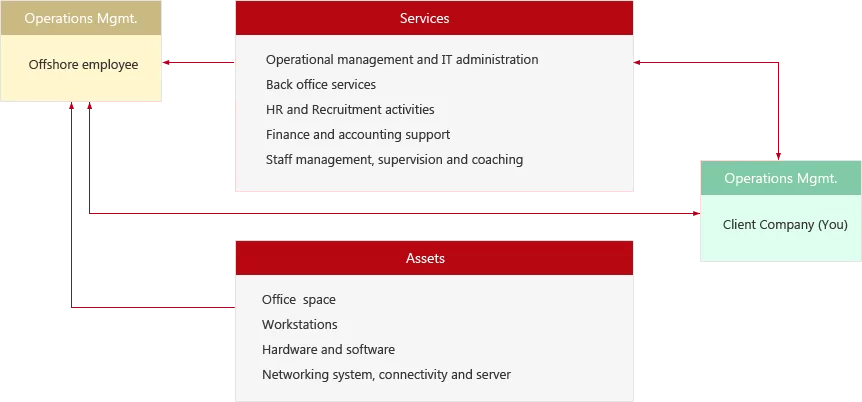Understanding Virtual Captives
In an outsourcing setup, the client delegates specific segments of their business operations to a service provider, entrusting them with end-to-end management. This arrangement means that the execution of responsibilities and associated risks are assumed by the third-party provider. To ensure the success of this offshoring structure, a foundation of trust and relationship between the client and the service provider is crucial.
On the other hand, in a captive setup, the client or parent company establishes a dedicated offshore resource base and retains complete control over business operations. However, this model has potential drawbacks, including longer setup times and substantial investments. Additionally, clients must possess knowledge of the offshore operations in the chosen country and understand how to operate effectively within that environment.
To address the limitations of both approaches, we’ve introduced a diagram below that outlines the pros and cons of these offshoring structures. We also introduce an innovative business model known as the “virtual captive,” which combines some of the benefits of captive and full outsourcing, offering a well-rounded solution.
Offshoring Structures Comparison
Traditionally, companies that are looking to assign some of their services or operations offshore resort to two main offshoring structures: (a) by tapping into an offshore outsourcing service or (b) by setting up a “captive” entity in their chosen country.
| Captives | Offshore Outsourcing | Virtual Captives | ||||||||
|---|---|---|---|---|---|---|---|---|---|---|
|
| |||||||||
Traditionally, companies that are looking to assign some of their services or operations offshore resort to two main offshoring structures: (a) by tapping into an offshore outsourcing service or (b) by setting up a “captive” entity in their chosen country.
In the case of a captive set up, the client or parent company creates a dedicated resource base offshore (basically a wholly owned subsidiary) and retains full control of the business operations. One problem with this model is that the time frame to establish a fully-functional captive center may take longer and may entail large investments. Additionally, it is necessary for the client to be knowledgeable about the offshore operations of the chosen country and knows how to operate there.
We have come up with a diagram below outlining the pros and cons of the aforesaid offshoring structures and we also introduce an effective new business model called virtual captive, which offers some of the benefits of captive and full outsourcing and addresses the limitations of the two.
Understanding Virtual Captives
If neither captive nor full outsourcing can provide the specific requirements of your business, the best choice would be the virtual captive model. With this set up you, the client, can tap into PrimeOutsourcing’s inherent skills and knowledge of offshore operations to establish your firm’s operations in the Philippines. PrimeOutsourcing will then provide all the resources you need for your offshore firm to become fully operational, including manpower, infrastructure and assets.
What makes this model better than full outsourcing and captive models is the strategic control of the physical operations of the business is completely in your hands. That means you have free reign on the workflow processes, utilization of IT assets and tools and staff supervision. In short, virtual captive is a flexible offshoring solution that offers the best of both worlds.
Refer to the diagram below to get a full grasp of how your virtual captive operation in the Philippines will work.
Virtual Captive as Foundation for Startup Ventures
Virtual captive can also be considered as an incubation- or foundation-type business model, which is especially useful for startup ventures but can be used by established companies as well.
On that note, PrimeOutsourcing’s virtual captive service will serve as your platform to quickly and cost-effectively test offshoring operations in the Philippines. Once underway, you may decide to completely transfer the entire operation to your own Philippine-based company–especially if you are looking at expanding your business or if you have a steady stream of projects–or continue working with PrimeOutsourcing. In most cases, clients settle for the latter option as it enables them to focus on their core operations and save them from the hassles of hands-on managing a Philippines-based firm.
Establishing Your Virtual Captive Center with PrimeOutsourcing
Setting up a small-scale virtual captive center with PrimeOutsourcing follows the same process as our outsourcing services. For more extensive offshore operations, however, please refer to the steps below:
1. Criteria and Goal Assessment
Once initial contact is made, we will closely define your business objectives, goals and needs and discuss current processes and changes that you want to execute and align them with the capabilities of PrimeOutsourcing. Further discussion will be made so we can thoroughly assess your criteria when it comes to manpower, support, infrastructure and management requirements and processes.
2. Solutions Preparation
Once we have reviewed and get a full understanding of your scope requirements, we will work on a proposal outlining the service delivery, pricing and other processes involved in the offshore operation. We will then present it to you for review and approval. During this stage, back-and-forth discussions can be expected until an agreement is reached regarding the terms of service, strategy and deliverables as well as pricing.
3. Service Contract Signing
A detailed contract will be signed to formalize the agreement. The contract will cover the complete details of your offshore operations, including service delivery, pricing, approximate start for each staff and other information relevant to the service we have agreed to.
4. Assembly of Project Management Team
As with any other offshoring model, the initial stage of setting up a virtual captive center is the most challenging. For this reason, a project management team comprised of members from your company and from PrimeOutsourcing will be created. Both sides will assign a project manager to coordinate and take charge of the team. A series of video conferencing calls will be undertaken by the project management team to track progress and prepare for the scheduled launch of the offshore operation.
5. Staff Acquisition
Taking cue from the manpower criteria you have provided, PrimeOutsourcing will be sourcing and screening candidates to find appropriately skilled staff who will be assigned to work on your projects. As the client, you may take charge of selecting your offshore staff, especially for senior positions, and decide to allow PrimeOutsourcing to handle the recruitment of associate level positions. Or, you may leave the entire recruitment process to us.
6. Infrastructure Setup and Stabilization
Our IT team will coordinate with you and the project management team to setup the IT and infrastructure assets that will be used for your offshore operation. In order to stabilize such systems, consultation and tests will be carried out.
7. Structure of Operations Governance
On this stage, the structure of operations management is established following the criteria set in Step 1. Details like control of offshore operation, reporting process, KPIs, metrics and task assignment will be thoroughly touched upon to ensure that they are aligned with the organizational goals.
8. Offshore Operation Launching
Launching of your offshore operation will be set once the key details (staff, infrastructure assets, management process, etc.) are in place.
9. Day-to-Day Operations
Daily operations will immediately roll out following the launching. The structure of operations governance that we have agreed on will be closely followed to ensure the success of your virtual captive. PrimeOutsourcing will also provide continued support to guarantee the smooth operations of your business.
Virtual Captive Service Cost
The costs of our Virtual Captive services may vary on the complexity of requirements and scope of work entailed. However, we do make sure that we will create a comprehensible and transparent pricing model so as to help you maximize the services we provide. Following below are the factors that will influence the cost of your virtual captive with PrimeOutsourcing.
Offshore staff costs

Infrastructure costs

Services costs

Understanding Virtual Captives
Virtual Captives combines the strengths of other business offshoring models in terms of control and risk sharing. As opposed to limiting the operations’ control and risk solely to the client’s or provider’s end, virtual captive provides the benefit of balancing the control and risk between the client and service provider.

Virtual Captives combine the strengths of the captive and 3rd party outsourcing models:
Reduced setup and ongoing costs
Creating a captive operation from the ground up entails substantial outlay to cover research, infrastructure, manpower and consultancy. In the case of virtual captive, however, setup cost is greatly reduced as the client can tap on the expertise and existing resources of an on-the-ground partner. Once the virtual captive is operational, overhead costs are still significantly lower than other offshoring models as pricing is streamlined to different cost elements (fix/variable) and asset-sharing between the client and service provider is allowed.
Lower risks
One distinctive feature of virtual captive is that risks are shared by both the client and service provide. The risk of setting up offshore operation in another country is eliminated since a local expert is there to manage the operation. Any resulting losses and costs of operation up to an agreed level are also shared.
Faster setup time
Given all the needed resources are on hand, including manpower, processes and infrastructure, setting up a virtual captive can be done in a few weeks, unlike with captive operation, which usually takes anywhere from six months to a year or more to set up.
Perfect balance of control and risk
Another great benefit that can be derived from virtual captive is that it presents a good balance of risk and control. The client retains full control of the business’s operations and with a greater ability to make decision comes the up-skill in offshore operations management, but without putting the entire fate of the company in a single offshore provider. The third-party service provider, on the other hand, shares part of the operational risks, but is assured that it will retain its local talents once the contract is through.

